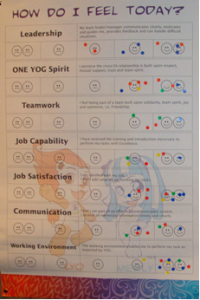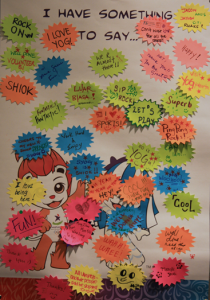Olympic Games are unthinkable without the invaluable support of thousands of volunteers. For most organising committees, this fact alone posts a major challenge in preparing and running the games since they often do not have experience in managing an army of unpaid workers. The always available IOC ‘cook book’ is not more than a good start, since the behaviour and attitude and hence the requirements for hiring and managing the crowd of helpers depends much more on the culture of the people with their upbringings, beliefs and traits, than it is influenced by instructions and SOPs. After all, an unpaid worker has nothing to lose. If he perceives being treated unfairly, he walks!
Whilst it is not unimportant to continuously engage volunteers and measure their pulse rate before the game, it is most vital to do so systematically and with very closed follow up loop during games time. Therefore, a survey (Figure 1) was designed to measure the degree of satisfaction in the categories leadership, One YOG spirit, teamwork, job capability, job satisfaction, communication and work environment. On the satisfaction chart the meaning of each category was explained as follows:
- Leadership: My manager communicates clearly, motivates and guides me, provides feedback and can handle difficult situations.
- ONE YOG Spirit: I perceive the cross-functional relationship as built upon respect, mutual support, trust and team spirit.
- Teamwork: I feel being part of a team built upon solidarity, team spirit, joy and optimism, i.e. Friendship.
- Job Capability: I have received the training and introduction necessary to perform my tasks with Excellence.
- Job Satisfaction: I am satisfied with my Job. I feel I add value by performing my tasks.
- Communication: I feel I am part of an effective communication system. I am receiving all necessary information timely and clearly.
- Working Environment: The working environment enables me to perform my tasks as expected by YOG.
By placing this chart at high-traffic areas such as at the entrance to the workforce rest area, it was made sure that it would be seen and used. This chart was continuously being monitored and interventions were derived by the respective Venue Workforce Managers and Venue Managers on daily basis. This EMO-chart (short form for the word ‘Emotional’) is a simple tool, that is combined with the so called I-have-something-to-say chart (Figure 2) that served the purpose of collecting any kind of feedback from volunteers they were not willing to share directly or express openly.
The job of the Venue Workforce Managers was to look out for signs of unhappiness and their root causes amongst the overwhelmingly very positive feedback. In many cases, this strategy has led to an early detection of issues that could be tackled before they could spread widely or grow into real problems. Such information was also fed back to the YOG Main Operations Centre (MOC) on daily basis and served as a way to provide measurements for workforce matters and hence create involvement of the other operational functions on workforce management. And, it has also been very useful for the MOC to share success stories from the ground.
For example could a reason for low rating in the category ‘Communication’ be identified as disappointment about last minute cancelations of training events of some sports teams. Volunteers were ready to perform but the actors were not able to make it. The organising committee took appropriate action to ensure better and faster communication.
Even if you are not able to ‘fix’ all the issues raised by workforce on these charts, they already feel better if they have a place to show their state of mind – before they do it on Facebook. These simple tools offer a way to vent for those who are bothered by something that is not big enough to be brought to their boss’s attention. Or, they just don’t want to speak up openly. Let them speak anonymously first. After earning their trust they will tell you.
Conclusion
It seems that this kind of measuring the “pulse of the workforce” tightly is appropriate for volunteers only because they need to be treated nicely otherwise they walk. Does this mean our workforce in private organisations or in public service do not deserve this kind of treatment? Is it really enough to measure the organisational climate once a year? Definitely not.
This kind of chart has been seen at the entrance of the call centre of a bank in Germany because the management understands the link between the mood of front-line staff and customer satisfaction. They wanted to measure the pulse of their staff closely. The customer on the line can feel the smile – or the frustrated face.
Measuring the pulse of your workforce was not too necessary decades ago when most employees were desperate to get employed and would sacrifice to keep their job. Now, ask yourself how many of your staff need the job you offer so badly. Probably only those whom you do not need anyway.



